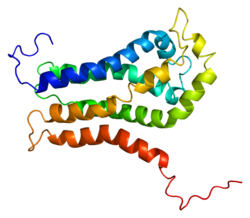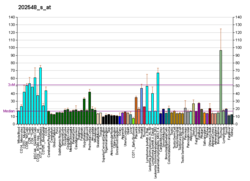Domains and functions
βPIX is a multidomain protein that functions both as a signaling scaffold protein and as an enzyme. [9] βPIX shares this domain structure and signaling function with the highly similar ARHGEF6/αPIX protein.
βPIX undergoes extensive alternative splicing to generate multiple variant proteins containing or lacking particular protein domains. [9] Adult forms all lack the amino terminal CH domain, and the two major adult variants have alternate carboxyl terminal region (termed β1 and β2): β1 forms contain the coiled-coil trimerization domain and the PDZ-target motif for binding to PDZ proteins (see below), while β2 forms lack both domains and their corresponding functions. [9]
βPIX contains a central DH/PH RhoGEF domain that functions as a guanine nucleotide exchange factor (GEF) for small GTPases of the Rho family, and specifically Rac and Cdc42. [6] Like other GEFs, βPIX can promote both release of GDP from an inactive small GTP-binding protein and binding of GTP to promote its activation. Signaling scaffolds bind to specific partners to promote efficient signal transduction by arranging sequential elements of a pathway near each other to facilitate interaction/information transfer, and also by holding these partner protein complexes in specific locations within the cell to promote local or regional signaling. In the case of βPIX, its SH3 domain binds to partner proteins with appropriate polyproline motifs, and particularly to group I p21-activated kinases (PAKs) (PAK1, PAK2 and PAK3). [6] PAK is bound to the βPIX SH3 domain in the inactive state, and activated Rac1 or Cdc42 binding to this PAK stimulates its protein kinase activity leading to downstream target protein phosphorylation; since βPIX can activate the "p21" small GTPases Rac1 or Cdc42 through its GEF activity, this βPIX/PAK/Rac complex exemplifies a scaffolding function.
Structurally, βPIX assembles as a trimer through a carboxyl-terminal coiled-coil domain that is present in the major carboxyl terminal splice variant β1, and further interacts with dimers of GIT1 or GIT2 through a nearby GIT-binding domain to form oligomeric GIT-PIX complexes. [9] Through this GIT-PIX complex, the scaffolding function of βPIX is amplified by also being able to hold GIT partners in proximity to βPIX partners. In contrast, β2 carboxyl terminal variants lack this coiled-coil region and are predicted to be unable to trimerize. The major carboxyl terminal variant β1 also has a PDZ domain binding target motif that binds to the PDZ domains in SHANK1, [10] scribble, [11] and SNX27 [12] proteins. Some splice variants of βPIX contain an amino-terminal Calponin Homology (CH) domain whose functions remain relatively poorly defined, but may interacts with parvin/affixin family proteins. [13] [9] βPIX variants with this extended amino terminal CH domain are most highly expressed early in development, but appear rare after birth. [9]
This page is based on this
Wikipedia article Text is available under the
CC BY-SA 4.0 license; additional terms may apply.
Images, videos and audio are available under their respective licenses.












